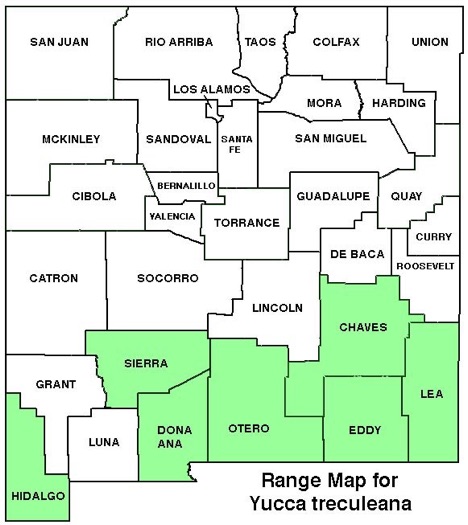WILDFLOWERS OF NEW MEXICO

Though native to extreme southern NM, this is one of the most popular yuccas used in landscaping throughout the state. It grows into a 10-foot or taller tree. The stem often branches with each limb topped with a rosette of leaves. A mat of shaggy dead leaves usually covers the lower portion of the trunk while the upper leaves below the rosette often grow in haphazard directions. Note the dagger-like leaves and flower stalk within the leaves.
FLOWER: April–May. The flower stalk with short branchlets bears a dense spike-like spray of flowers totally or partially enclosed within the leaves. The fleshy, egg-shaped, creamy-white flowers, often tinged with red, are 1–3-inches long (2.5–7.5 cm). Fruit matures into a dry capsule 1 3/4–7 3/8-inches long (4.5–19 cm) with 3 chambers filled with flat, black seeds. The thick, fleshy capsules hang down and do not split open when dry but by winter have usually weathered and lost their seeds.
LEAVES: A dense rosette of stout, dagger-like leaves tops each short limb of the trunk. The blades reach 14–50-inches long, 5/8–2 3/4-inches wide (1.5–7 cm), are U-shaped and tipped with a vicious thorn; margins entire and lined with coarse threads.
HABITAT: Dry, rocky, sandy soils of hills, mesas; desert grasslands and scrub, pinyon-juniper.
ELEVATION: 3,500–5,700 feet.
RANGE: NM, TX.
SIMILAR SPECIES: This species was originally separate from Y. torreyi, with Y. torreyi having free leaf threads and Y. treculeana without. They are now lumped as Y. treculeana with a gradual east-west transition from south Texas to NM. Soaptree Yucca, Y. elata, in the so.half of NM, has rosettes with 1/2-inch wide (12 mm), flexible leaves. Faxon Yucca, Y. faxoniana, in so. NM border counties into Texas, reaches 8–29-feet tall, has a flower stalk that begins blooming above the leaves, and hanging capsules that do not split open when dry.
NM COUNTIES: Southern NM in low-elevation arid habitats: Chaves, Dona Ana, Eddy, Hidalgo, Lea, Otero, Sierra.
NOTES: Yuccas and the moths that pollinate them are totally dependent on each other, often with one species or variety of moth dedicated to a single species of yucca. The small, white moth gathers a ball of pollen and at the next flower stuffs it in the specially designed stigma. She then lays eggs in the pollinated ovary so the larva can feed on the developing seeds. The larvae emerge, leaving numerous undamaged seeds, and pupate in the ground. Flowers unfertilized by the moth don’t form capsules. The petals drop leaving the bare flower stem on the dead stalk.

TRECUL YUCCA
YUCCA TRECULEANA (includes YUCCA TORREYI)
Asparagus Family, Asparagaceae (formerly in Agave Family, Agavaceae)
Perennial shrub



THE CONTENTS OF THIS WEBSITE ARE COPYRIGHTED AND CANNOT BE USED
WITHOUT PERMISSION OF GEORGE OXFORD MILLER



The flower stalk starts blooming within the leaves.




Thick, fleshy fruit pods hang downward, and do not split open when dry.

EMAIL ME